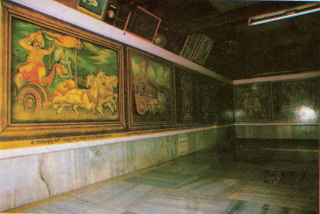|
History Of Temple
|
Kanipura (or kaniyara) is yet another familiar name for the coastal town
of kumbla, situated about eight miles due north of Kasaragod town. It
was the original seat of the Raja of Kumbla, which was later on
shifted to mayipadi (Mayapuri). Even to this day we could see the ruins
of the fort at Kumbla or Kotekar and Arikadi, which bear testimony to
the political importance of Kumbla in the days gone by. Kanipura is
only a derivative of Kanvapura. Tradition ascribes the Prathishtah of
Sri Gopalkrishna Moorthi of the temple to Kanva Maharshi form whom the
name of the place is derived. The other place names such as
Kannur (also called Kanva Peetah) within two miles to the east of the
temple and the well known Kanva Teertha of the Pejavar Mutt fame near
Manjeshwar, also are indicative of the faith of the people in the many
legends relating to the association of the sage Kanva with this temple and the place around if.
|
|
The legendary Sthala-Purana of the temple has it that having installed
the idol, which is a most beautiful image of
Balagopalakrishna in jet black granite, an idol which was being
worshipped by the fostermother Yashoda, the sage performed Adhishekam to
the deity with the Manthrodaka which he had saved in his Kamandalu
during ages past; the Manthrodaka then flower out as a stream, grew in
to a river and ultimately joined the western sea within a short distance
form the temple. The river is “Kumbha Hole”, (Hole means river) also
known as the Kumbhini. The town as well came to be known as Kumbla form
this.
|
|
The temple, for which
extensive repairs and renovations have been carried out recently, is
situated in the heart of the town of Kumbla at the foot of an
elevated hill which rises majestically in front of it, with the
river Kumbha Hole flanking if on the left (north). If
Srimadanantheshwara, and Sri Vinayaka of Madhur are the deities of the daily worship of the senior Raja of
Kumbla, the patta Abhisheka or coronation of the senior Raja would in
ancient days take place in Kanipura Sri Gopalakrishna temple. The
Abhisheka of the Yuvaraja of Kumbla used to take place at Srimath
Udaneshwara Temple of perdala, which in Kumbla Seema is only next in
importance to the above four temple.
|
|
 Kanipura Sri Gopalakrishna’s praises have been sung by Parthi Subba,
the father of Yakshagana, along with those of Madhur Sri Mahaganapathi,
in many an immortal song. In fact it was in Kumbla that Parthi Subba was
born and bred up (in about 1740 to 1800 A.D) and composed
all his yakshagana prasangas which earned for him the title of the father of
Thenkku Thittu Yakshagana. He was in the line of the Paatalies of the
Kumbla temple, and at the Moodappa seva in Madhur temple in 1797 had
presented a copper “Dhara Battal” to that temple inscribed with his
name in Kannada, which is in use at the Madhur temple even to this day.
The colourful festival at the Kumbla temple which lasts five days every
year commences with Dhwaja Arohanam on the Makara Sankramana day every
year. People in their thousands gather at these festivities. The temple
draws a tasdik of Rs. 200/- a year and regular poojas are being offered
to the Deity.
Kanipura Sri Gopalakrishna’s praises have been sung by Parthi Subba,
the father of Yakshagana, along with those of Madhur Sri Mahaganapathi,
in many an immortal song. In fact it was in Kumbla that Parthi Subba was
born and bred up (in about 1740 to 1800 A.D) and composed
all his yakshagana prasangas which earned for him the title of the father of
Thenkku Thittu Yakshagana. He was in the line of the Paatalies of the
Kumbla temple, and at the Moodappa seva in Madhur temple in 1797 had
presented a copper “Dhara Battal” to that temple inscribed with his
name in Kannada, which is in use at the Madhur temple even to this day.
The colourful festival at the Kumbla temple which lasts five days every
year commences with Dhwaja Arohanam on the Makara Sankramana day every
year. People in their thousands gather at these festivities. The temple
draws a tasdik of Rs. 200/- a year and regular poojas are being offered
to the Deity.
|
|
There is subsidiary
shrine of sri Mahaganapathi in the southern courtyard of this temple. It was consecrated and Brahmakalasha was
performed a few years ago, thanks to the efforts of Sri K. Srinivasa
Nayak, who has even made an endowment for the poojas and naivedya of
this deity. There are also subsidiary deities in the temple namely
Vanashastha, as well as the Pilichamundi Daiva. Daily pooja for the former, and periodical thambila for the latter are
performed.
|
|
